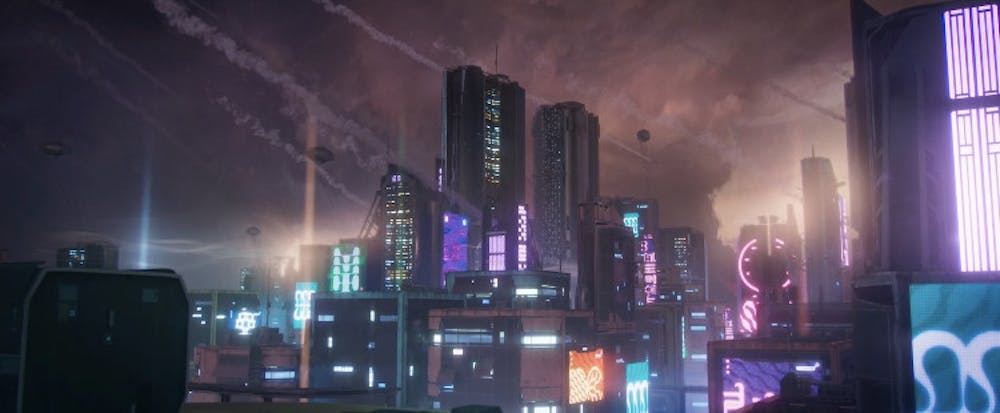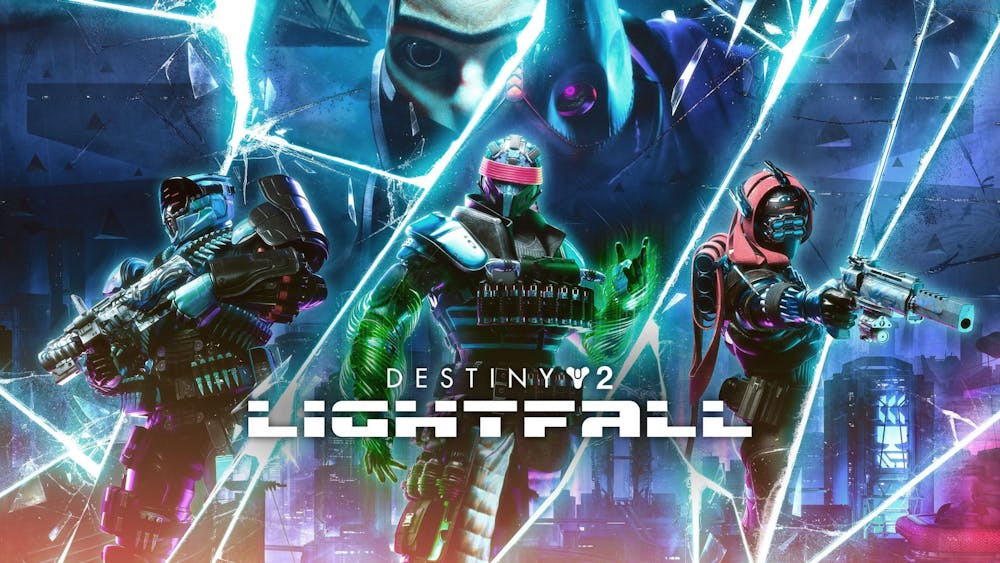The opinions and views expressed in this article are those of the author and do not reflect the opinion of Byte or Byte’s editorial board.
The newest expansion for Bungie’s live service looter-shooter is out and features a brand new campaign, explorable destination, abilities and gear. Many positive additions and changes have been made, especially within the quality of life sector, yet the expansion’s narrative is extremely flawed, leaving an unsatisfying feeling for what is supposed to be the climax for Destiny 2’s almost ten-year narrative.
Witnessing a disappointment
Destiny 2: Lightfall’s campaign brings players to the planet Neptune in a city called Neomuna. Here, the Witness (Brett Dalton), an ancient evil powered by the powers of the Darkness, seeks a powerful artifact known as The Veil. Players must now fight the Witness’ new disciple, the Cabal Emperor Calus (Darin DePaul), and his dark legion with the help of two of Neomuna’s protectors, known as the Cloud Striders, as well as Osiris (Oded Fehr). This narrative rarely gets any more complex, and characters are left horribly underdeveloped. For most of the story, Osiris is a grumpy prick who won’t stop whining about the mission, and a moment at the end of the second act meant to feel emotional instead feels hollow. The most annoying part of the campaign, though, is how almost none of the questions it poses about the game’s world are answered, and players are instead left with an anticlimactic cliffhanger to tide them over until the next season or expansion that might shed light on these topics. However, while Lightfall’s narrative falls short, the campaign’s gameplay is pretty good. On the legendary difficulty, enemies pose enough of a threat to make players think quickly and consider making builds, but are not so oppressive that they will have you cowering in a corner (for the most part). A new addition to the game is a new enemy type: the Tormentor. This hulking monstrosity can only be damaged in certain weak points and wields attacks that can disable your abilities or drain your health. These new enemies add another level of challenge to any encounter you’re in, as you will certainly want to get them off the playing field as soon as possible. Some levels bring other gimmicks as well, such as a vehicle section, a short gauntlet of combat and traversal, and a defense section that sees the player alongside some allies fending off against the combined might of the Cabal Shadow Legion.
The first Strand-type subclass
Alongside a new campaign, Destiny 2: Lightfall provides players with a full new suite of abilities under a new element: the subclass of Strand. While this new subclass may seem underwhelming when you are forced to interact with it in the campaign without a proper build, plenty of opportunities are given to the player post-campaign to wreak havoc with this new power.

The first and most notable addition alongside Strand is the grapple, which is available on all three classes, and replaces what would usually be your grenade ability. This ability does what you might expect, and allows players to swing through the air and gain momentum, with the added bonus of being to follow up with an in-air melee attack that deals a substantial amount of damage to lower ranking enemies. Strand also brings with it a variety of new status effects that help to immobilize enemies and negate damage, as well as allowing players to spawn small slug-like “threadlings” that seek out enemies and deal explosive damage. With these new effects, as well as individual super abilities for each class, Strand stands as a formidable ability set that prioritizes mobility and horde clearing, allowing for some truly fun gameplay moments.
Not-so-Neomuna
Destiny 2: Lightfall brings with it a brand new explorable destination: the Neptunian city of Neomuna. According to the game’s lore, the city has remained hidden from the rest of humanity for the past few centuries, and thus has become a thriving metropolis free from most of the strife that has faced the rest of the Solar System. However, despite the location’s intriguing backstory, there is very little to differentiate it from the rest of the explorable locations in the game when it comes to gameplay. The main activity players take part in is a public event in one of three of the location’s zones based on a daily rotation.

Screenshot from in-game cutscene
The issue with this activity is that its public nature means there is no dedicated matchmaking, and you could end up in the area all by yourself. The city’s citizens are nowhere to be found, instead appearing in the form of vaguely human-shaped holograms as some sort of virtual avatars while the actual citizens are said to be sleeping in cryostasis in order to shelter from the ongoing siege. While this does make some sense narratively, it leaves Neomuna feeling bare and lifeless, as the entire location is mostly sleek metal architecture with little to no wildlife to be seen. Some of the available side quests are somewhat interesting, including a post-campaign quest that delves more into the Cloud Striders who have protected the city of Neomuna for generations. Some exotic rewards from Neomuna include a machine gun that synergises with void elemental debuffs, a heavy glaive that freezes and slows entire rooms full of enemies, and a Strand sidearm that can fire heat-seeking bullets. Ultimately, while Neomuna can offer some interesting rewards, there probably won’t be much reason to come back after you get what you want.
Laying foundations
Alongside the new expansion, various new quality of life changes were made to the game in order to improve some of the game’s core systems. The first of these systems is the Guardian Rank system. With Guardian Ranks, players are given different sets of goals per level in order to provide some mild guidance to players and to be a display of one’s skills and accomplishments. Ranks one through six contain objectives that ease new players into various parts of the game, while ranks seven through 11 contain much more difficult objectives that indicate a player’s time investment. While this system seems to have some issues, specifically within higher levels, the earlier stages seem to be a much better onboarding system for players as opposed to the previous system, which left many new players feeling lost and aimless with nothing to do. Another system improved upon this year is buildcrafting. A new part of the user interface allows players to customize all of their armor modifications in one place. This customization system has also been drastically simplified, making this system much more intuitive. While some parts of the armor customization system are stripped down, this seems to be a solid foundation for future updates to come. Bungie has also tweaked certain difficulty modifiers in most player-versus-environment activities to various degrees of success. In some cases, this can feel like a welcome challenge, but can also make previously fun activities a slog to get through now.
Sweet nightmares
The final piece of content included in Destiny 2: Lightfall is a brand new raid titled “Root of Nightmares.” This raid sees players traversing a dark pyramid ship overtaken by light-based flora as they fight various forces of the Cabal and solve combat puzzles. I’m not the biggest expert on raids, as I usually only play in smaller groups and don’t get the chance to play them, but I was lucky enough to get a clear on this one. As raids go, the puzzle solving mechanics are fairly simple throughout the entire raid, and the two bosses present have surprisingly low amounts of health. Overall, this raid is significantly easier than many of its predecessors, although I still found it to be quite enjoyable. The weapons and armor rewarded have an interesting aesthetic, as well, and the narrative content within the raid is quite interesting, as an ominous voice will taunt the player up until the final boss fight.
Conclusion
Destiny 2: Lightfall makes many missteps in its path to become the penultimate chapter in the game’s “Light and Darkness Saga.” The expansion’s narrative is embarrassingly lackluster, especially in comparison to last year’s The Witch Queen. The new location, Neomuna, has more style than substance, and the newest piece of pinnacle content is probably much easier than it should be. However, that doesn’t stop Bungie from making multiple improvements to the game that will likely stand as long-lasting benefits. The Strand subclasses provide some of the best ability-based gameplay in the series, the new Tormentor enemy type provides a worthy challenge to players, and the newest quality-of-life changes set the foundations for a more rewarding and accessible game in the future.

Sources:
Bungie, Bungie, IMDb, IMDb, IMDb
Photos
Contact Ian Case with comments at ian.case@bsu.edu




















